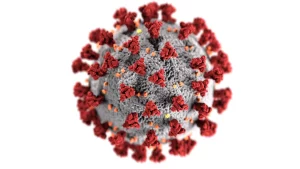10 Long COVID facts

We will now describe 10 in depth facts about Long COVID.
Key Points
- Recovery: most people recover from coronavirus (COVID-19) in 1-2 weeks. In a few people symptoms last longer than 12 weeks – not explained by an alternative diagnosis.
- Symptoms: vary widely and can affect multiple organ systems, making diagnosis and management complex.
- Risk factors: include severe initial illness, pre-existing conditions, and female gender.
- Management: involves a multidisciplinary approach, focusing on symptom relief and rehabilitation.
- Vaccination: preventing COVID-19 through vaccination remains the most effective way to reduce the risk of long COVID.
1. Definition
- Long COVID, also known as Post-COVID-19 Syndrome, is defined as a set of symptoms persisting for more than 12 weeks after the initial COVID-19 infection, which cannot be explained by an alternative diagnosis
- Symptoms can fluctuate or relapse and may affect multiple organ systems, making it a challenging condition to diagnose and treat.
2. Epidemiology
- Prevalence: An estimated 10-20% of individuals who contract COVID-19 may develop long COVID, although this varies by study and population
- Age and gender: It can affect all age groups, including children, but is more commonly reported in adults. Studies indicate a higher prevalence in women
- Severity of initial illness: Patients with severe COVID-19, those requiring hospitalization, and individuals with pre-existing health conditions are more likely to develop long COVID, although it can also occur after mild or asymptomatic infections.
3. Risk factors
- Severity of initial COVID-19: Higher risk in those with severe illness
- Hospitalisation: Especially those admitted to ICU
- Pre-existing conditions: Diabetes, hypertension, obesity, and respiratory diseases
- Age: Increased age has been linked with higher risk, though younger patients can also be affected
- Gender: Women may be more susceptible to developing long COVID
- Ethnicity: Some studies suggest a higher risk among ethnic minorities, possibly linked to disparities in healthcare and underlying conditions.
4. Cause
The cause of long COVID is unknown. Possible mechanisms include:
- Ongoing viral activity: Persistence of the virus or viral particles.
- Immune dysregulation: Hyperinflammatory responses leading to tissue damage.
- Autonomic nervous system dysfunction: Explains symptoms like palpitations and fatigue.
- Endothelial damage and microvascular changes: May contribute to symptoms like brain fog and muscle pain.
5. Symptoms
The symptoms of long COVID are varied and can affect multiple systems. They include:
- General: Fatigue, malaise, fever
- Respiratory: Breathlessness, cough
- Neurological: Brain fog, headaches, dizziness, sleep disturbance
- Cardiovascular: Palpitations, chest pain
- Gastrointestinal: Diarrhoea, nausea, abdominal pain
- Musculoskeletal: Joint and muscle pain
- Psychological: Anxiety, depression, mood swings.
6. Diagnosis
Diagnosis of long COVID is clinical:
- Based on a history of previous COVID-19 infection with persistent symptoms beyond 12 weeks
- It is a diagnosis of exclusion, meaning other conditions must be ruled out
- Many chronic autoimmune diseases are in the differential diagnosis – e.g. rheumatoid arthritis, SLE etc
- Ensure a comprehensive history is taken, focusing on the timeline of symptoms, severity, and their impact on daily life.
Investigation
Investigations are primarily aimed at ruling out other conditions:
- Blood tests: Full blood count, CRP, liver and kidney function, glucose, and thyroid function tests
- Imaging: Chest x-ray (or better CT scan) if there are ongoing respiratory symptoms
- Cardiac tests: ECG, echocardiogram, or Holter monitor if palpitations or chest pain are reported
- Pulmonary function tests: If there are signs of breathlessness or reduced exercise tolerance
- Neuroimaging: MRI or CT if there are persistent neurological symptoms that are unexplained.
Differential diagnosis
- Chronic fatigue syndrome/Myalgic Encephalomyelitis (CFS/ME)
- Anxiety and depression
- Pulmonary embolism
- Chronic Obstructive Pulmonary Disease (COPD)
- Cardiac conditions: Arrhythmias, cardiomyopathy.
7. Treatment
Management of long COVID requires a multidisciplinary approach:
- Symptom-specific Treatment: Tailor treatment to specific symptoms, e.g. bronchodilators for breathlessness, analgesics for pain
- Rehabilitation: Pulmonary and physical rehabilitation to improve exercise tolerance and muscle strength
- Mental health support: Psychological support or therapy for those experiencing anxiety, depression, or PTSD
- Patient education: Educate patients on symptom pacing, rest, and energy conservation
- Follow-up: Regular review of patients’ symptoms and adjustments to management plans as needed.
8. Complications
- Chronic respiratory issues: Persistent breathlessness or reduced lung function
- Cardiac complications: Myocarditis, arrhythmias, or postural orthostatic tachycardia syndrome (POTS)
- Neurological sequelae: Cognitive impairment, chronic headaches, peripheral neuropathy
- Mental health conditions: Anxiety, depression, PTSD.
There is more information on the complications of long COVID here.
9. Prognosis
- The prognosis for long COVID is variable. Many patients report gradual improvement over time, but symptoms can persist for months or even years in some cases.
- Recovery can be prolonged and unpredictable, with symptoms often fluctuating.
- Early intervention and a comprehensive care plan can significantly improve quality of life and outcomes.
10. Prevention
The best approach to reducing the risk of long COVID is through prevention of COVID-19 itself:
- Vaccination: COVID-19 vaccines have been shown to reduce the risk of developing long COVID, even if breakthrough infections occur
- Public health measures: Continued adherence to infection control measures, especially in high-risk settings
- Early management: Appropriate and early treatment of acute COVID-19 may help prevent the development of long COVID.
Summary
We have described 10 in depth facts about about Long COVID. We hope it has been helpful.
Top Tip – Long COVID
Its important to exclude other chronic autoimmune diseases – e.g. rheumatoid arthritis, SLE etc.

